The 1960 penny is a 1-cent coin produced by the US Mint in 1960. As a 60-plus-year-old coin, the 1960 penny is quite popular among collectors.
If you want to learn more about the value, composition, and design of the 1960 penny, then you need to continue reading.
What Is the 1960 Lincoln Penny Made Of?
The 1960 Lincoln penny is made of 95 percent copper, and the rest is made of tin and zinc. This has been the composition of Lincoln pennies from 1909 to 1982, except in 1943, when copper was made with zinc-plated steel. From 1982 to this day, the Lincoln penny was made of 97.5% zinc and 2.5% copper.
The 1960 Lincoln penny has a plain edge, a weight of 3.11 grams, and a diameter of 19 millimeters.
The Lincoln penny is among the oldest coins that the US Mint is still producing. Starting in 1909, there are now billions upon billions of Lincoln pennies.
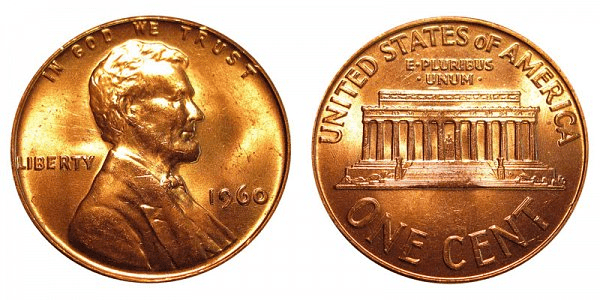
Victor David Brenner designed the obverse of the 1960 Lincoln penny. His design proves to have stood the test of time since it has been used since 1909. He also originally designed the coin’s reverse side, which features two stalks of wheat.
However, in 1959, the wheat design was replaced by the Lincoln Memorial design. So, the year 1960 was the second time the Lincoln penny featured the Lincoln Memorial design.
1960 Lincoln Penny Varieties
The US Mint produced more than two billion Lincoln pennies in 1960. The 1960 Lincoln penny comes in different varieties. What’s interesting about this year is that the Philadelphia and Denver Mint produced different varieties. So, you get two types of pennies from the same mint center.
The difference is caused by the year 1960. There were two variants which included the small and large dates. The reason for this was that in 1960, the US Mint discovered that the die they were using was subject to breakage, particularly on the “0” on the date of 1960.
Because of this, the US Mint created a new die with a bigger date to ensure the error would not happen again. With this in mind, the small date variants were made first, and then the large date variants replaced them later. The US Mint produced fewer pennies with a small date than with a large date.
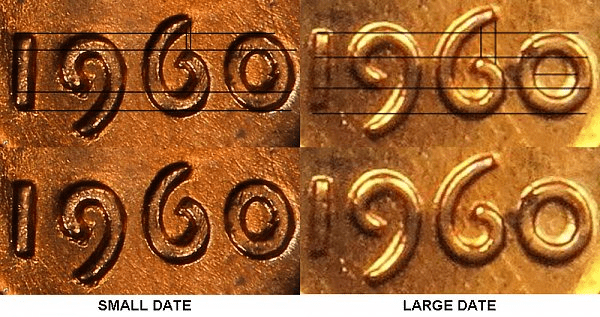
Aside from the regular pennies, there are also some notable error coins that we will discuss later.
Here’s a table to help you see the penny’s variety and mintage:
| Variety | Mint Location | Mintage |
| 1960 D Lincoln Penny | Denver | 1,580,884,000 |
| 1960 P Lincoln Penny | Philadelphia | 586,405,000 |
| 1960 Proof Wheat Penny | Philadelphia | 1,691,602 |
| Total | 2,306,780,606 |
Here’s a deeper look at each of the 1960 penny varieties:
1960 D Lincoln Wheat Penny
Year of minting: 1960
Mint Mark: D
Place of minting: Denver
Quantity produced: 1,580,884,000
Face Value: $0.01 (one cent)
Price: $0.01 to $0.35 (circulated condition)
Mass: 3.11 grams
Edge: Plain
Designer: Victor David Brenner
Composition: 95% Copper, 5% Tin and Zinc
Diameter: 19.00 mm
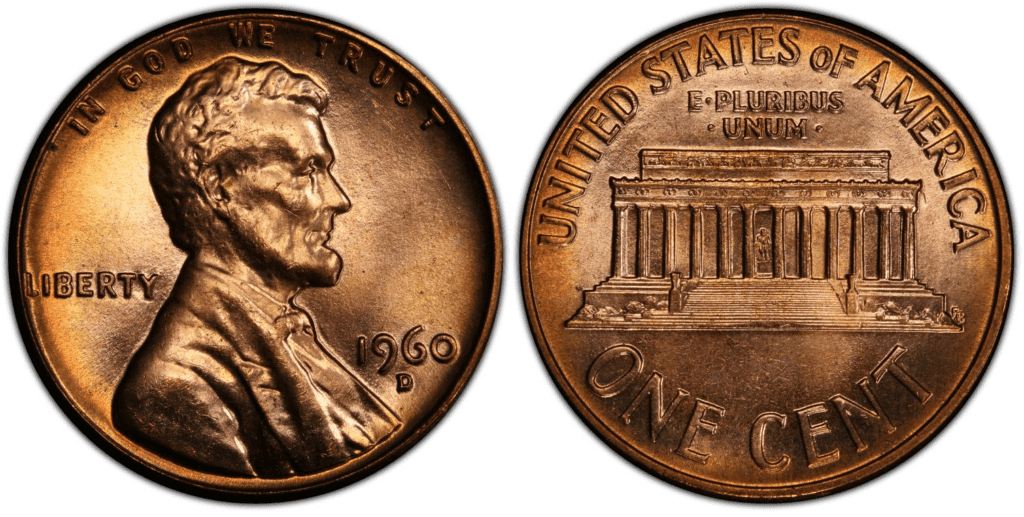
The Denver Mint produced more than 1.5 billion pennies in 1960, which is an impressive feat for a mint center. However, you would be surprised that in the following years, the Denver Mint would repeatedly produce more than what was produced in 1960.
1960 P Lincoln Wheat Penny
Year of minting: 1960
Mint Mark: none
Place of minting: Philadelphia
Quantity produced: 586,405,000
Face Value: $0.01 (one cent)
Price: $11 or more (uncirculated condition)
Mass: 3.11 grams
Edge: Plain
Designer: Victor David Brenner
Composition: 95% Copper, 5% Tin and Zinc
Diameter: 19.00 mm
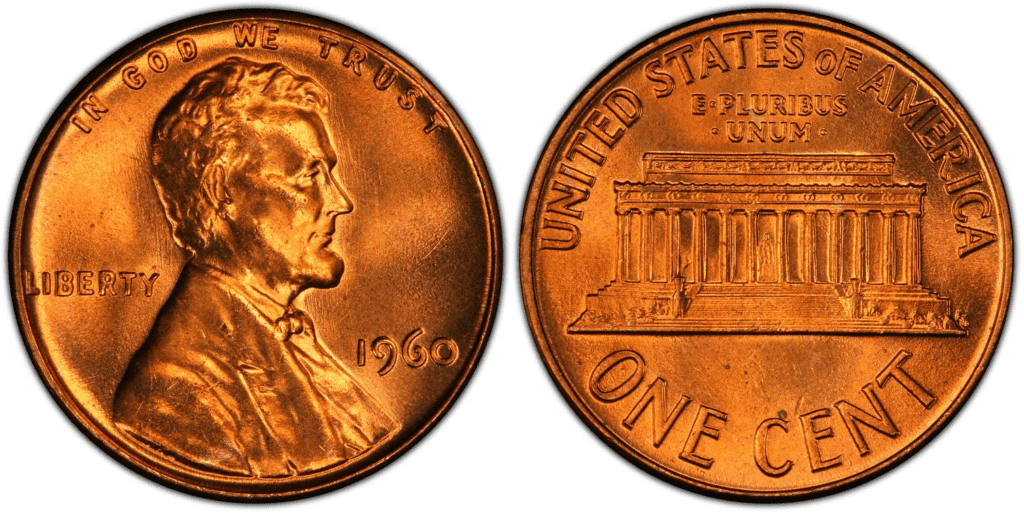
Like the Denver Mint, the Philadelphia Mint produced small and large date variants. The mint in Philadelphia produced more than 586 thousand pennies.
1960 Proof Lincoln Wheat Penny
Year of minting: 1960
Mint Mark: D
Place of minting: Denver
Quantity produced: 1,691,602
Face Value: $0.01 (one cent)
Price: $0.01 to $0.45 (circulated condition)
Mass: 3.11 grams
Edge: Plain
Designer: Victor David Brenner
Composition: 95% Copper, 5% Tin and Zinc
Diameter: 19.00 mm
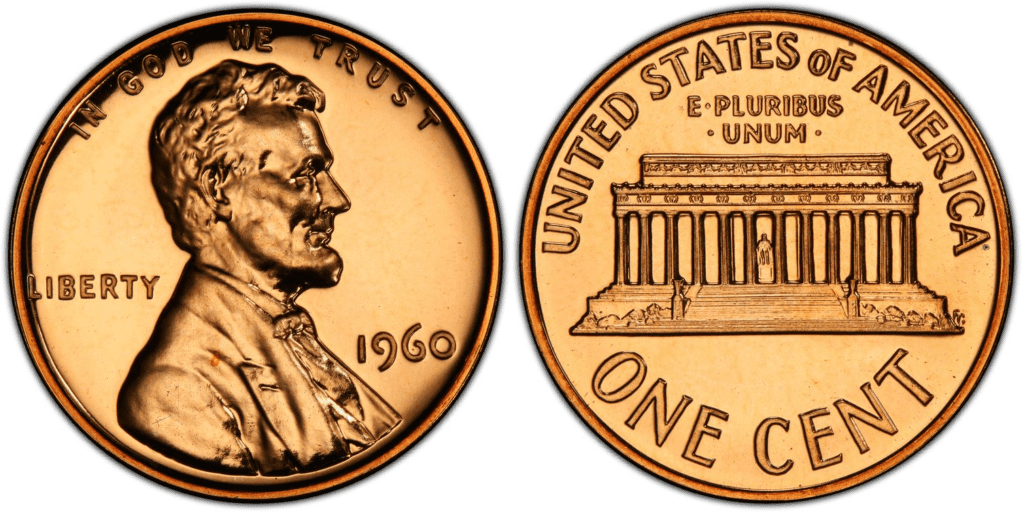
The Philadelphia Mint produced proof pennies in 1960. The demand for proof pennies by this time continues to rise. Proof coins are more difficult and time-consuming to produce. However, they are more attractive and valuable than regular coins.
List Of 1960 Lincoln Penny Errors
With more than two billion Lincoln pennies produced, it is not surprising to see that error coins were also released in circulation. Here are some examples of the 1960 Lincoln penny errors:
Repunched mintmark (RPM)
The only mintmark in the 1960 penny is the D mintmark, indicating that the coin was struck in the Denver Mint.
The RPM error happens when the mint mark is punched twice on the planchet. Usually, RPMs are hardly noticeable. However, the coin can become highly valuable when the RPM error is prominent.
Here’s an example of a 1960 penny with an RPM error:
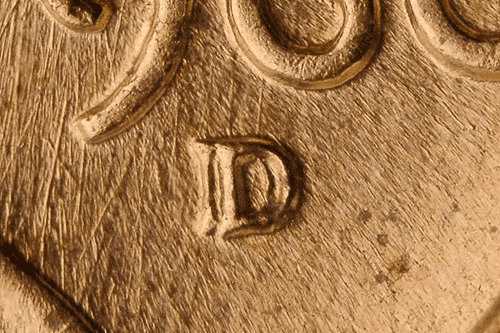
Cracked skull error
In this error, the head of Lincoln comes with a curve line, which makes his head look like it has a crack. Here’s how it looks:
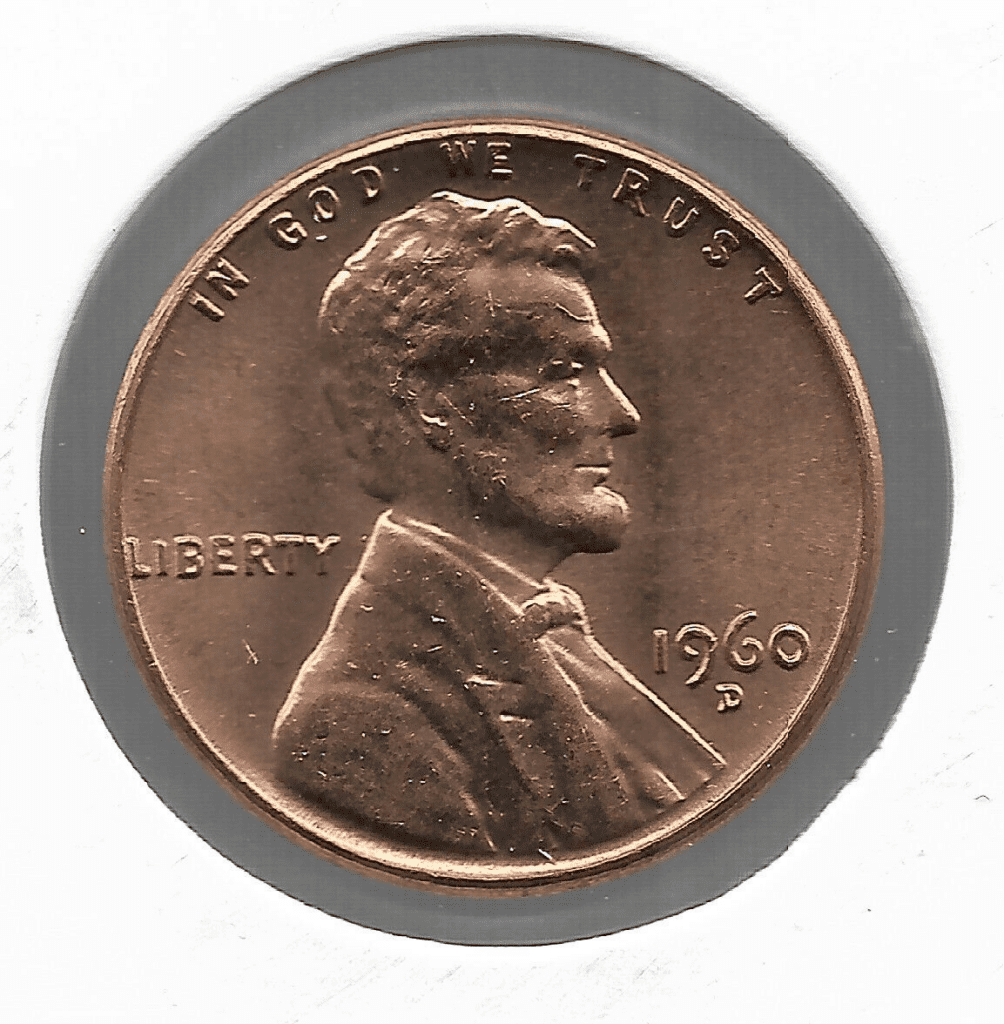
A die break causes the cracked head error. As you can imagine, producing thousands of pennies daily stresses the die. Given enough time, it will break, and the die’s crack will also be engraved on the planchet.
Doubled die error
The doubled die error happens when the die strikes the planchet twice. Usually, doubled die errors aren’t noticeable since the second strike would hit the same angle of the planchet. However, the error would become prominent if the second strike hits at a different angle.
Many coin collectors put a great premium on doubled die error, especially when the doubling effect of the error can easily be seen.
Here’s an example of a 1960 doubled die penny error:
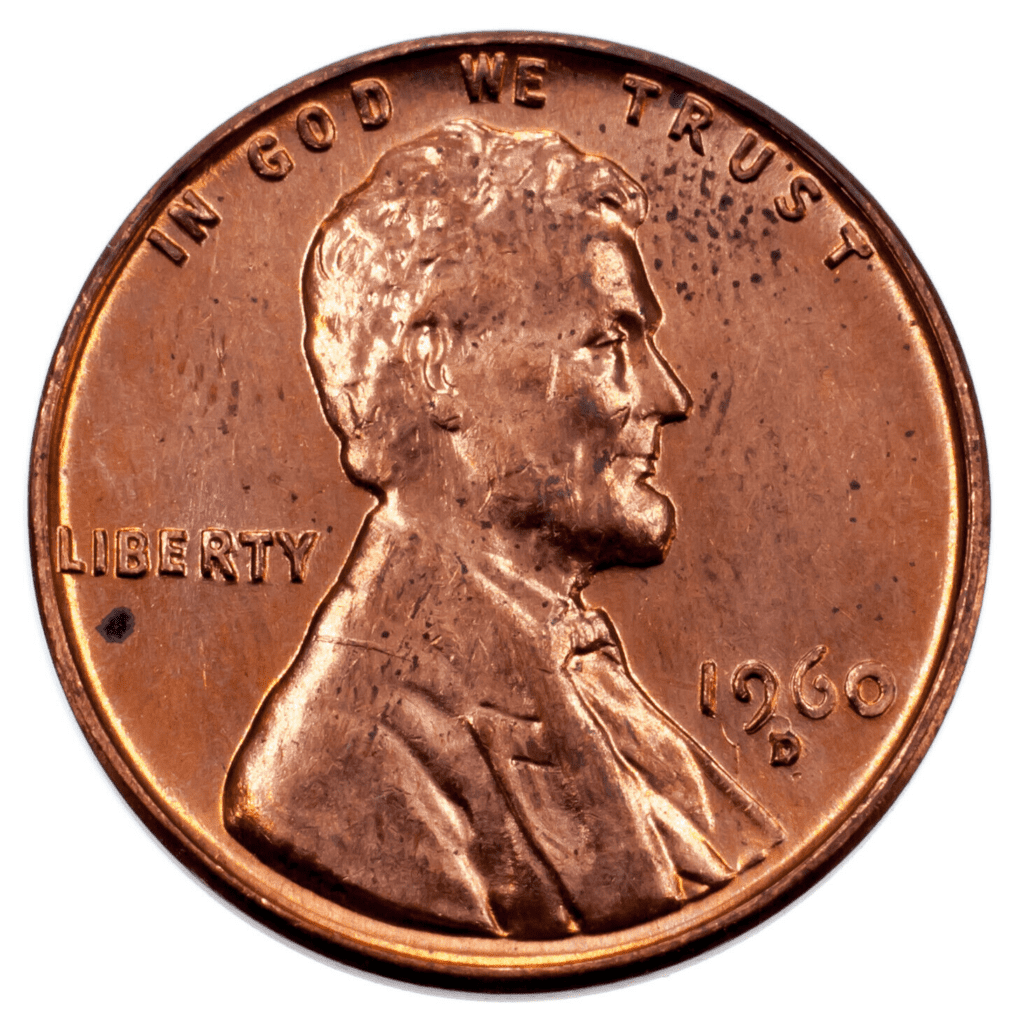
How Much Is the 1960 Lincoln Penny Worth Today?
The 1960 Lincoln penny has a face value of one cent. Since it doesn’t have precious metals, the 1960 Lincoln penny can be traded at face value. However, the melt value can be around 2 cents for its copper content.
Since 1960 pennies can be considered an old coin, some people might be willing to pay for it more than its face value. Nevertheless, a circulated 1960 penny might only be valued at less than one dollar.
Given the right condition, 1960 Lincoln pennies can be super valuable. To truly appreciate the value of the 1960 pennies, here is a table that shows you the auction records for each variety:
| Coin | Condition | Grade | Sold date | Sold by | Value |
| 1960 D Wheat Penny (Large Date) | Superb Gem Uncirculated | MS 67 – Red | February 24, 2018 | eBay | $20,000 |
| 1960 Proof Wheat Penny (Small Date) | Superb Gem Uncirculated | PR 68 – Deep Cameo | March 17, 2011 | Heritage Auctions | $5,188 |
| 1960 P Wheat Penny (Small Date) | Superb Gem Uncirculated | MS 67 – Red | December 4, 2008 | Heritage Auctions | $4,600 |
| 1960 Proof Wheat Penny (Large Date) | Superb Gem Uncirculated – Red | PR 69 – Deep Cameo | January 7, 2004 | Heritage Auctions | $4,370 |
| 1960 Wheat Penny – D over D error | Gem Uncirculated | MS 66 – Red | July 30, 2008 | Heritage Auctions | $4,025 |
| 1960 P Wheat Penny (Large Date) | Superb Gem Uncirculated – Red | MS 67 – Red | December 5, 2013 | Heritage Auctions | $3,819 |
| 1960 D Wheat Penny (Small Date) | Superb Gem Uncirculated – Red | MS 67+ – Red | July 15, 2021 | Legend Rare Coin Auctions | $3,525 |
How Does The Grading System Work?
The 1960 penny is graded with the use of the Sheldon Scale. The scale comes with a 70-point grading system. The appraiser would look at the condition, strike, preservation, and color of a 1960 penny to determine what grade it should receive.
Professional numismatists joined in the 1970s and established CoinGrading standards, known as the Sheldon Scale. These numismatists now assign grades at key places on the seventy-point scale, using the most regularly utilized numeric points in conjunction with the original adjective grade. The following are the most common coin grades:
- (P-1) Poor – Indistinguishable and probably damaged; if used, must have a date and mintmark; otherwise, rather battered.
- (FR-2) Fair – Nearly smooth, but without the damage that a coin graded Poor often possesses. The coin must have enough detail to be identified.
- (G-4) Fair – Inscriptions have merged into the rims in some areas, and important elements have been mostly erased.
- (VG-8) Very Good- A little weathered, but all primary design elements are visible, albeit faintly. There is little, if any, central detail left.
- (F-12) Good – The item is very worn, yet the wear is even, and the overall design details stand out clearly. Rims are almost completely isolated from the field.
- (VF-20) Very Fine – Moderately weathered, with some finer features still visible. The motto or all letters of LIBERTY are readable. Both sides of the coin have entire rims separated from the field.
- (EF-40) Extremely Fine – Gently used; all gadgets are visible, and the most important ones are bold. The finer details are bold and clear; however, light wear may be seen.
- (AU-50) Uncirculated – Slight evidence of wear on the coin’s design’s high points; it may have contact marks; eye appeal should be adequate.
- (AU-58) Uncirculated Choice – Slight traces of wear, no severe contact marks, almost full mint shine, and great eye appeal.
- (MS-60) Mint State Basal – Strictly uncirculated; no indication of wear on the coin’s highest points, but an unsightly coin with reduced luster, visible contact marks, hairlines, and other flaws.
- (MS-63) Mint State Acceptable – Uncirculated, but with contact scratches and nicks, little reduced shine, but otherwise appealing appearance. The strike is weak to average.
- (MS-65) Mint State Choice – Uncirculated with great mint shine, little contact blemishes, and exceptional eye appeal. The strike is unusually severe.
- (MS-68) Mint State Premium Quality – Uncirculated with superb luster, no obvious contact marks to the naked eye, and exceptional eye appeal. The strike is quick and appealing.
- (MS-69) Almost Perfect Mint State – Uncirculated with perfect brilliance, a sharp and appealing strike, and extremely good eye appeal. A near-perfect coin with minor imperfections in the planchet, strike, and contact markings (seen only under 8x magnification).
- (MS-70) Mint State Perfect – Under 8x magnification, no tiny imperfections are discernible; the strike is crisp, and the coin is perfectly centered on a beautiful planchet. Rarely seen on a coin, this coin is bright and whole, with original luster and exceptional eye appeal.
For the penny, there’s one particular designation given to it based on its color — Brown, Red and Brown, and Red. The redder the color of the penny, the higher its value and grade.
If you wish to get your coin graded, contact specialists from PCGS, NGC, IGC, and ANACS.
Are There Any Rare 1960 Lincoln Penny?
Perhaps, the rarest 1960 Lincoln pennies would be the ones with the small dates and the D over D error. As mentioned above, the small, dated 1960 Lincoln pennies are fewer in numbers compared to the large ones.
Plus, if that coin with a small date also has a D over D error, then that would truly make the coin extra rare. Rare 1960 Lincoln pennies in superb condition can be worth several hundred or even thousand dollars.
Where To Buy Or Sell 1960 Lincoln Penny?
The 1960 Lincoln penny can be both online and offline. You can search Google online and search for buyers and sellers of 1960 Lincoln pennies. This is the easiest and quickest way to find coins today.
Aside from the Internet, you can also buy or sell Lincoln pennies in coin shops and antique stores. Although, it may take you longer to find your desired pennies since not all of these places have 1960 Lincoln pennies. Of course, contact them to see if they can buy your 1960 Lincoln penny.
FAQs
How can you tell if a 1960 penny is a small date?
You can tell if a 1960 penny is a small date by looking at the numbers 1 and 9 in 1960. If a 1960 penny has a small date, the upper tips of the “1” and “9” are of the same level. On the other hand, a large date will show you that the “1” is lower than the “9.” Moreover, the large date has a long tail in the number 6.
Why is a 1960 D penny rare?
The 1960 D penny is rare if it has the D over D error. This coin indicates a repunched mintmark; the more prominent the error, the rarer the coin gets.
What is the error on a 1960 penny?
There are different errors in 1960 pennies. These include repunched mintmark, off-center strike, die break, clipped planchet, and doubled die.
